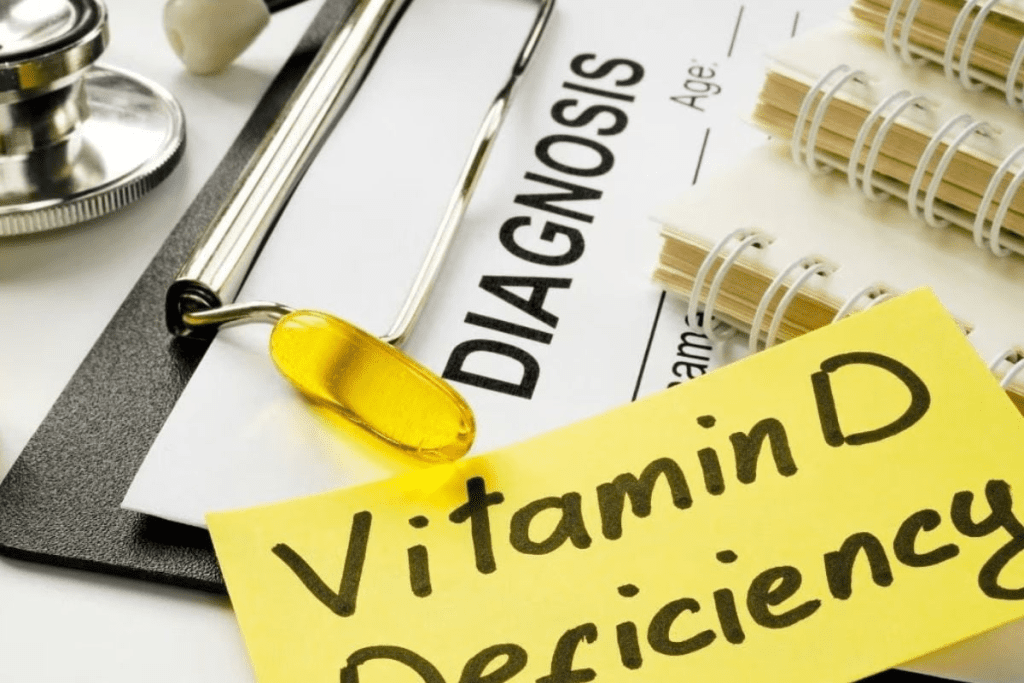Last Updated on November 25, 2025 by
Recent studies suggest a possible link between high vitamin D levels and Peyronie’s disease, a condition marked by penile fibrosis and curvature. A 2019 case‘control study reported significantly higher serum vitamin D in men with Peyronie’s compared to controls, highlighting vitamin D and Peyronie’s risk as a potential association that warrants further research.

The study found that men with Peyronie’s had a mean serum vitamin D level of 32.6 ng/ml. This is much higher than the 18.5 ng/ml in the control group.
This new evidence hints at a connection between elevated vitamin D levels and a higher risk of Peyronie’s disease.
Peyronie’s disease is a chronic condition that affects adult males. It is found in different parts of the world. This disease causes the penis to curve and hurt during an erection because of scar tissue.

Peyronie’s disease happens when scar tissue forms in the penis. This tissue is in the layer that surrounds the main part of the penis. The disease is not common, affecting between 0.5% to 13% of men.
It mostly affects men between 40 and 60 years old. But, it can happen to anyone. The exact reason for Peyronie’s disease is not known. It’s thought to be caused by genetics, environment, and lifestyle.
The main symptom is a penis that curves during an erection. This can be painful. Men may also feel pain or tenderness in the penis. Sometimes, a lump can be felt where the penis curves.
The disease can get better or worse over time. Finding out how vitamin D levels affect Peyronie’s disease might help find new treatments.
Looking into how vitamin D affects Peyronie’s disease is complex. A 2019 study gives us a closer look at this connection.
A 2019 study looked at vitamin D and Peyronie’s disease. It found interesting results. The study compared vitamin D levels in men with and without Peyronie’s disease.
Key findings showed a big difference in vitamin D levels. This suggests that higher vitamin D might increase the risk of Peyronie’s disease.

The study found a big gap in vitamin D levels. Men with Peyronie’s had 32.6 ng/ml, while those without had 18.5 ng/ml. This big difference points to vitamin D’s role in the disease.
These findings suggest that high vitamin D levels could lead to Peyronie’s disease. This might happen through inducing TGF-β1 expression and causing fibrosis in the penis.
These studies show a link between vitamin D and penile fibrosis. More research is needed to understand the molecular pathways involved.
Recent studies have found a link between too much vitamin D and Peyronie’s disease. This link needs more study. High vitamin D levels might affect how our bodies work, leading to Peyronie’s disease.
Too much vitamin D can make Peyronie’s disease worse by increasing TGF-β1. TGF-β1 is a protein that causes too much tissue to form. This can lead to the curved and painful penis seen in Peyronie’s disease.
A study in the PMC shows TGF-β1’s role in tissue diseases.
High vitamin D levels can also cause more fibrous tissue in the penis. This tissue forms plaque, which can bend the penis and cause pain. So, vitamin D might make Peyronie’s disease worse or increase the risk of getting it.
Too much vitamin D can also make soft tissues harden faster. This hardening, or calcification, can make the plaque in Peyronie’s disease worse. Vitamin D helps control calcium, and too much can lead to more calcium in tissues.
Lastly, high vitamin D levels can change how collagen is made. Collagen is important for skin and tissue structure. In Peyronie’s disease, collagen is not made right, leading to plaque. Vitamin D might affect this balance, causing too much collagen.
Knowing how vitamin D affects Peyronie’s disease is key. Healthcare providers can help manage vitamin D levels to lower the risk of Peyronie’s disease.
Vitamin D is key, but too much can raise Peyronie’s disease risk. We must grasp these factors to manage our risk well.
High cholesterol is a heart disease risk and might also affect Peyronie’s disease. Studies show men with high cholesterol are more likely to have penile curvature and other Peyronie’s symptoms.
Key considerations:
Diabetes can up the risk of Peyronie’s disease. The link might be due to diabetes’s inflammation and oxidative stress.
Important aspects to consider:
Cardiovascular disease includes heart disease and stroke. Men with these conditions are more likely to get Peyronie’s disease.
Key connections:
Genetics can significantly influence Peyronie’s disease. Men with a family history are more at risk.
Considerations for genetic predispositions:
Understanding these risk factors and their interaction with vitamin D helps us manage Peyronie’s disease risk better.
Knowing the signs of vitamin D toxicity is key. It happens when you take too much vitamin D. This can lead to serious health problems.
Vitamin D toxicity symptoms can differ from person to person. You might feel nausea and vomiting, weakness, or excessive thirst and urination. In severe cases, it can harm your kidneys and cause calcification of soft tissues.
Other signs include fatigue, headaches, and loss of appetite. If you’re taking vitamin D supplements and notice these symptoms, see a doctor right away.
To diagnose vitamin D toxicity, blood tests are used. These tests check your calcium and vitamin D levels. High levels can mean you have a problem.
Serum calcium levels are very important. High calcium levels are a sign of toxicity. Tests may also show elevated creatinine levels, which can mean kidney issues.
Doctors look at both symptoms and test results to make a diagnosis. They might also check parathyroid hormone (PTH) levels to see how your body reacts to vitamin D and calcium.
It’s important to understand these tests and criteria. This helps manage vitamin D toxicity and avoid serious problems.
To lower the risk of Peyronie’s, it’s key to know how to handle vitamin D supplements. This means looking at guidelines for supplements, eating foods rich in vitamin D, and checking vitamin D levels often.
The right amount of vitamin D supplements varies by person. It depends on age, skin color, and where you live. Adults usually need 600 to 800 IU a day, but some might need more. Always talk to a doctor to figure out the right amount for you.
Foods like fatty fish, egg yolks, and fortified dairy are good for vitamin D. But, supplements are also important for those who don’t get enough. It’s best to eat well and use supplements if needed, not just supplements alone.
Checking vitamin D levels in your blood is very important. It helps adjust how much you take and keeps levels healthy. Doctors can do tests to see how much vitamin D you have.
Vitamin D levels change with the seasons because of sun exposure. In winter or where it’s dark, you might need more supplements. But in sunny times, you might need less.
Using these tips, you can manage your vitamin D well and lower Peyronie’s risk. It’s all about finding what works best for you.
The treatment options for Peyronie’s disease are growing. We’re looking at both old and new ways to help. This includes understanding how vitamin D might play a role in the disease.
Hyperthermia, or using heat, is being studied as a treatment. It tries to make the plaque smaller and the penis straighter. Early studies show it might help, but more research is needed.
Vitamin D’s role in Peyronie’s disease is getting more attention. It might help by controlling the buildup of scar tissue. But finding the right amount is key to its effectiveness and safety.
There are many treatments for Peyronie’s disease. These include pills and surgery. Pills like pentoxifylline aim to reduce plaque. Surgery is for more serious cases.
Each treatment is chosen based on how bad the disease is and the patient’s health. A good treatment plan might mix different approaches, depending on the patient.
The link between vitamin D and Peyronie’s disease is complex. Research shows too much vitamin D might lead to this condition. Finding the right balance in vitamin D supplements is key to preventing Peyronie’s.
Keeping vitamin D levels in check is vital for our health. Our study found that managing vitamin D intake can lower Peyronie’s disease risk. Knowing the dangers of too much vitamin D and its symptoms helps us stay healthy.
We suggest a careful approach to taking vitamin D supplements. Regular blood tests and adjusting doses based on the season and health needs are important. This way, we can enjoy vitamin D’s benefits without its risks.
Studies show men with Peyronie’s disease have more vitamin D than those without it. This suggests a possible link between too much vitamin D and Peyronie’s disease.
Too much vitamin D might lead to Peyronie’s disease. It can cause TGF-β1 to be made more, leading to fibrosis. This can also speed up tissue calcification and change collagen production, causing plaques to form.
Vitamin D toxicity symptoms include nausea, vomiting, and weakness. It also shows up in blood tests as high calcium levels.
To manage vitamin D, follow the right supplement guidelines. Choose food sources over supplements when possible. Check your blood levels often and adjust your intake with the seasons to stay balanced.
Treatments for Peyronie’s disease include traditional methods and new approaches like hyperthermia. Moderate vitamin D levels might also help in treatment.
Yes, controlling vitamin D levels can help prevent Peyronie’s disease. It’s important to keep a balance to avoid risks.
Yes, other factors like high cholesterol, diabetes, heart disease, and genetics can increase Peyronie’s disease risk. These factors, along with vitamin D levels, are important to consider.
Vitamin D can change how collagen is made. This might help Peyronie’s disease develop by creating fibrotic plaques.
TGF-β1 is key in Peyronie’s disease. It helps create fibrosis and contributes to plaque formation.
Subscribe to our e-newsletter to stay informed about the latest innovations in the world of health and exclusive offers!